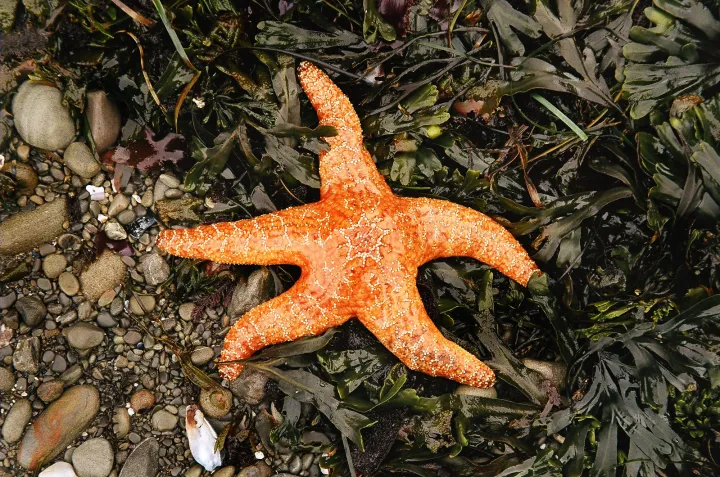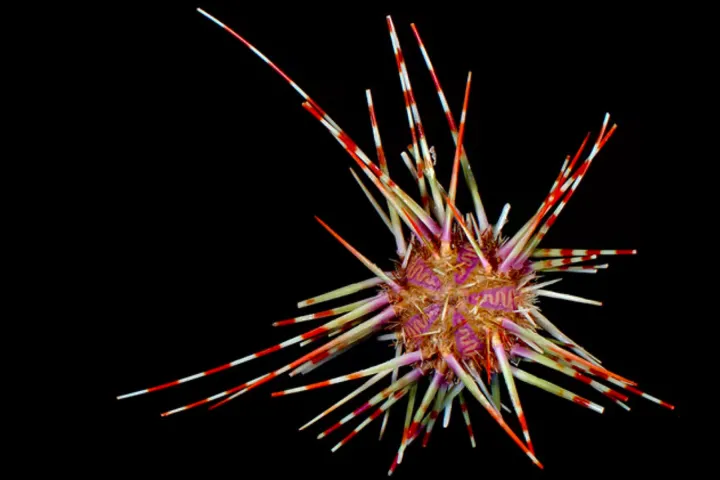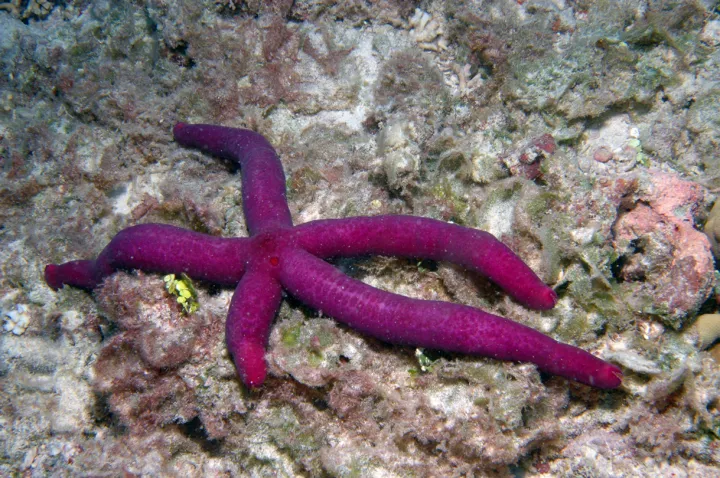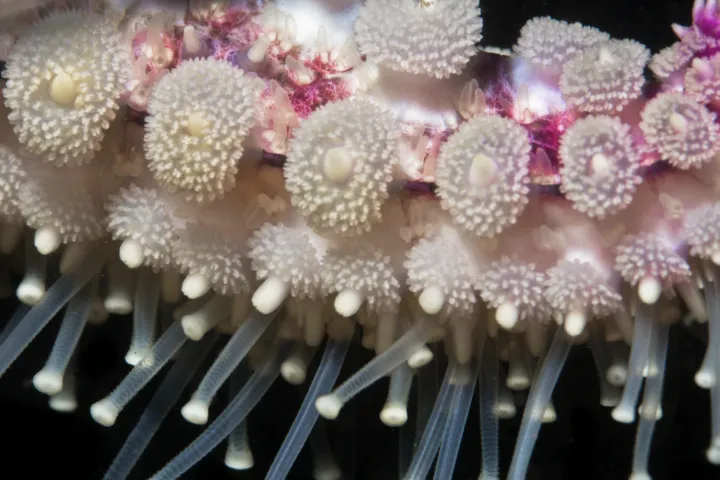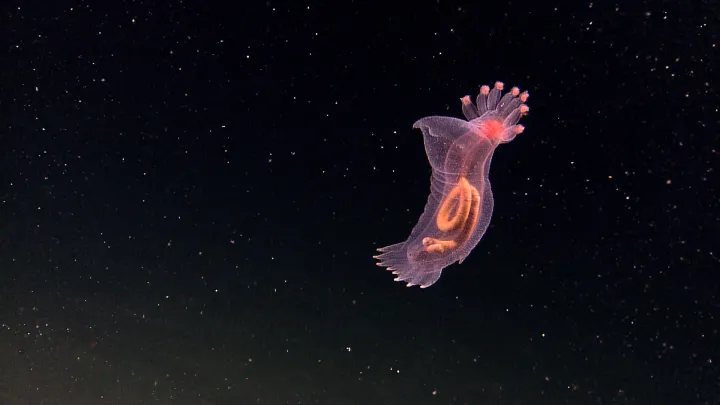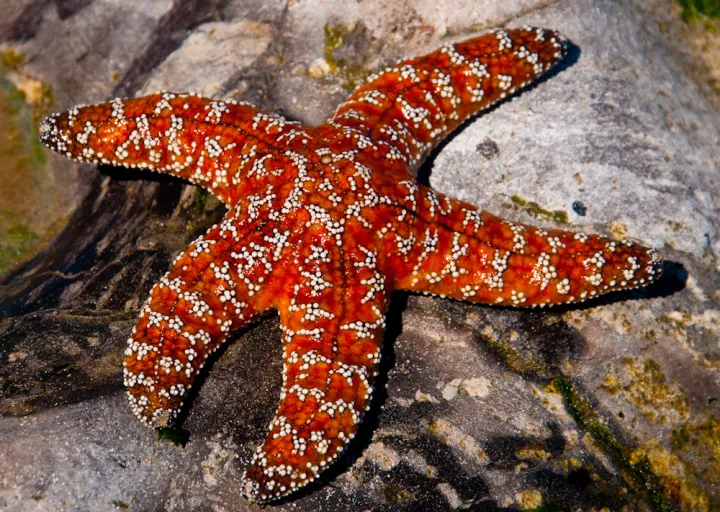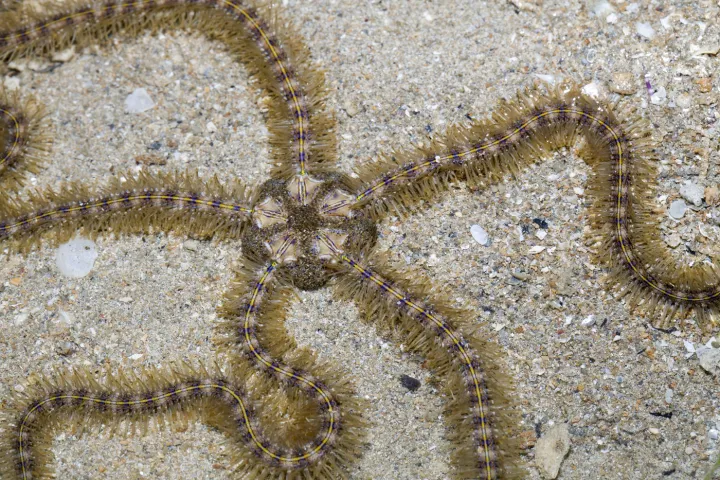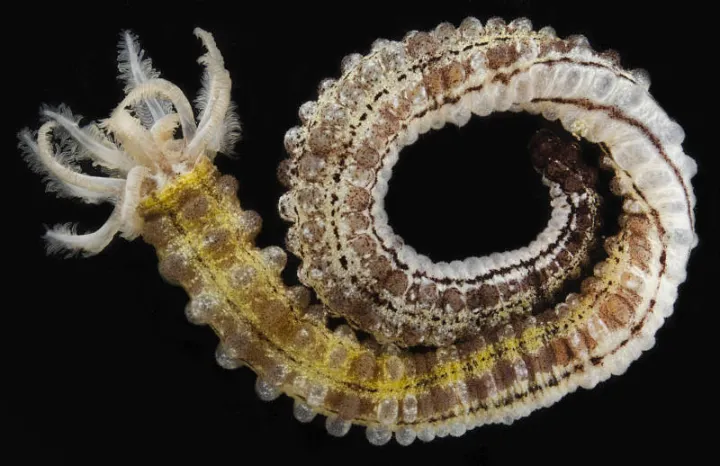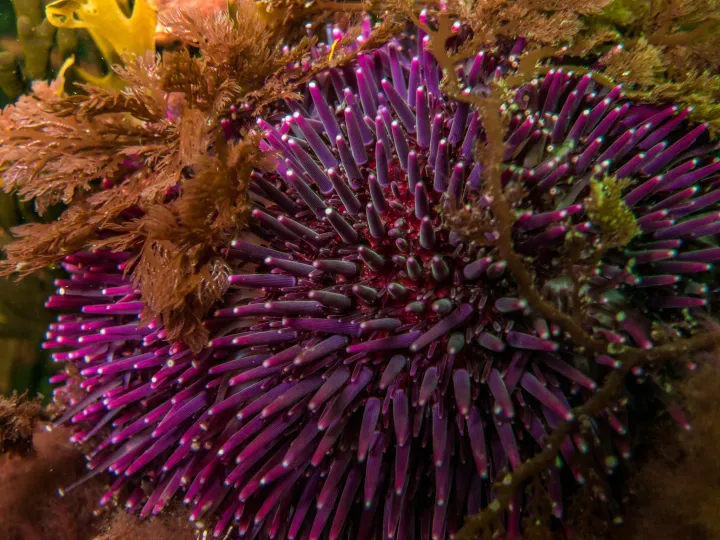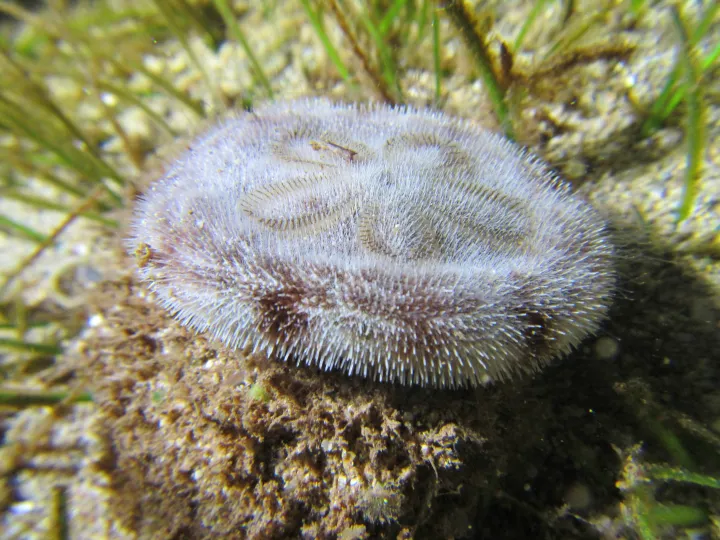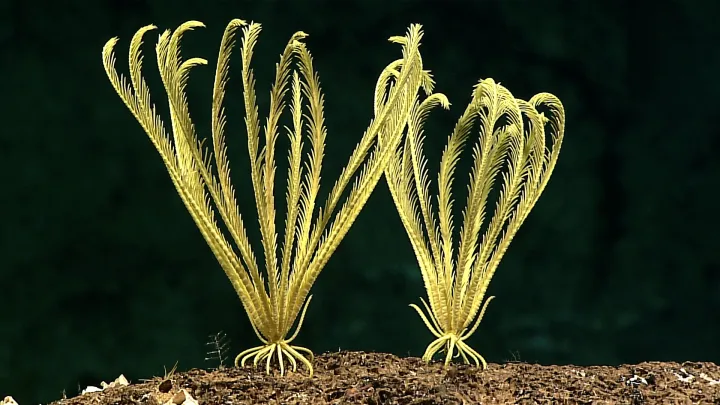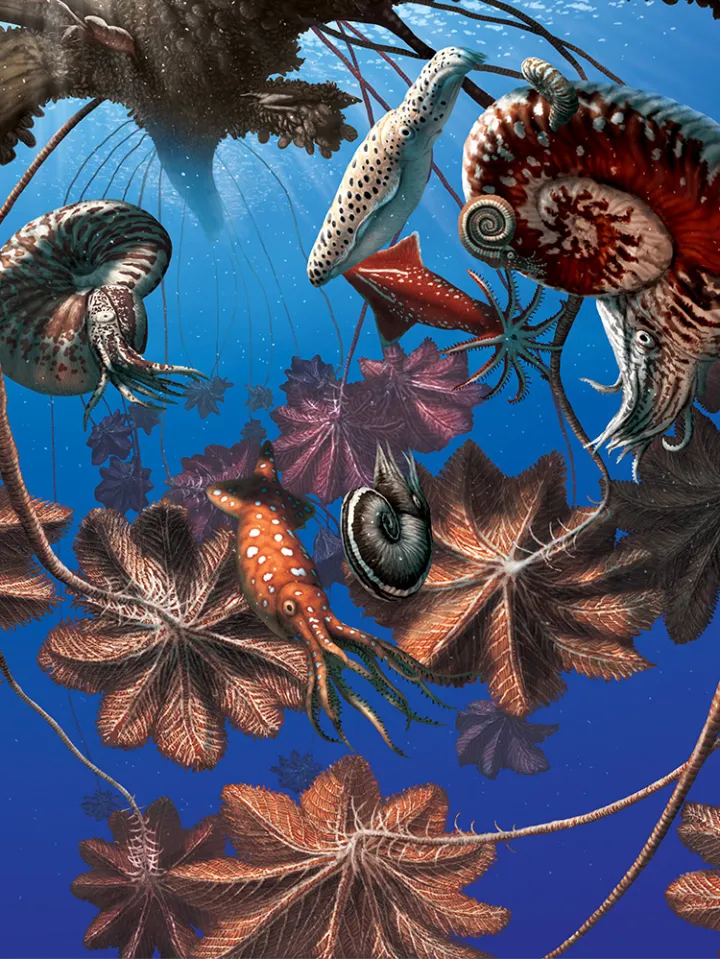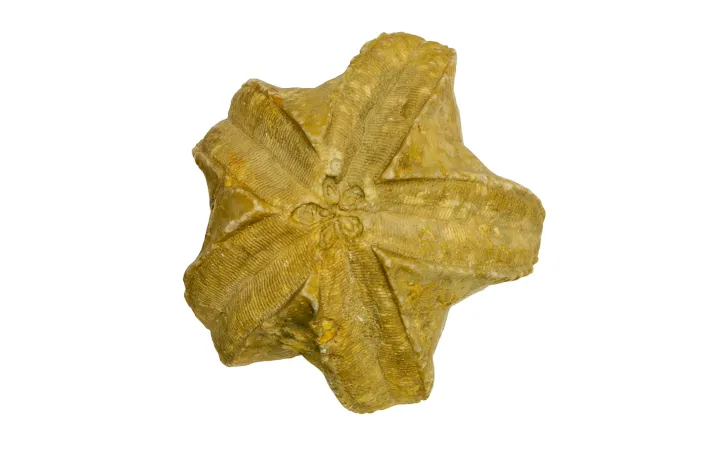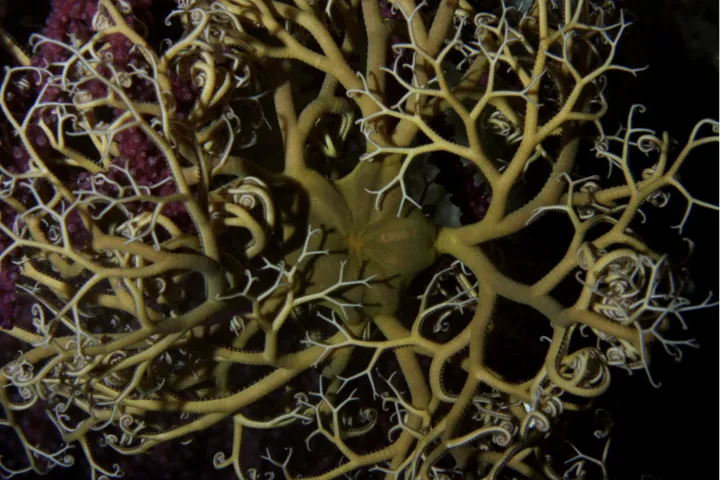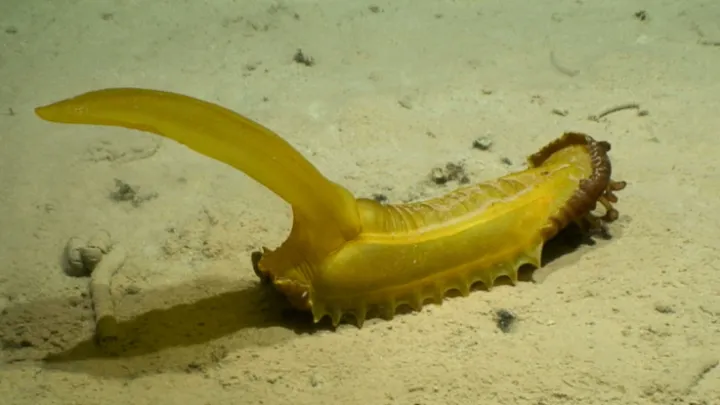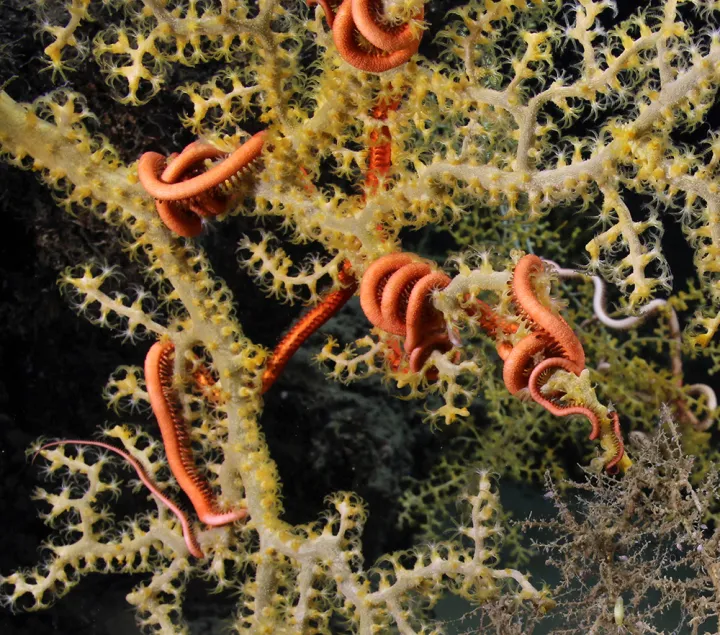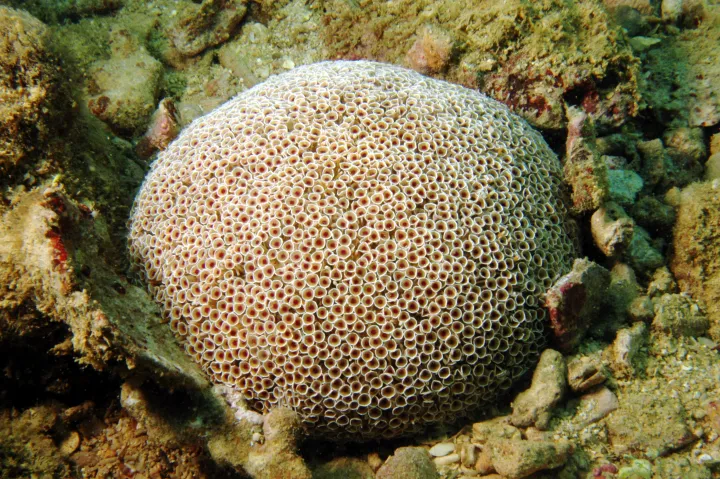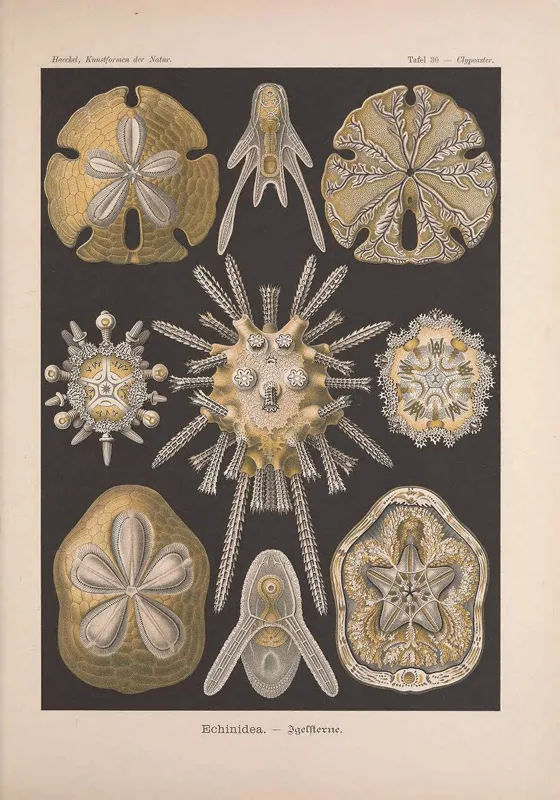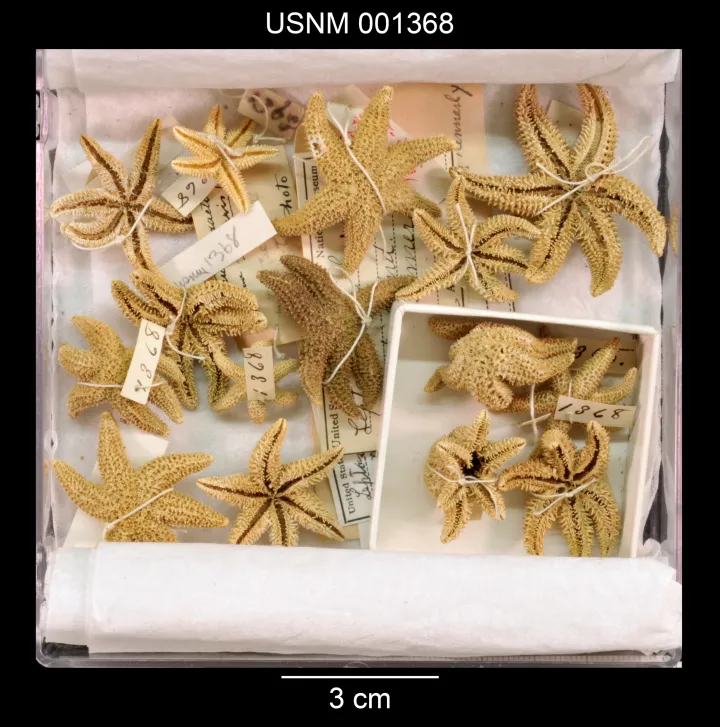
Sea Stars, Urchins, and Relatives
Introduction
Beachcombers and tide pool explorers may be familiar with sea stars, sea urchins, and sand dollars, but what many may not know is that all three are related. Additionally, sea cucumbers, brittle stars, and sea lilies, less known animals of the ocean, round out the family tree. Together, these animals make up the Echinodermata, a word with Greek origins meaning “hedgehog skin.”
Echinoderms live in every ocean, even off the coast of Antarctica. Well known as coastal dwellers, they can be found at depths over three miles deep (5,000 meters). Some are stealthy predators, pursuing prey with speed and agility, while others feed on drifting detritus while stuck in place, more similar to a billowing field of ferns.
Are You An Educator?
Anatomy, Diversity, and Evolution
Anatomy
Body Plan
In a typical sea star, it is easy to see the classic five-fold symmetry that is characteristic of echinoderms. This includes arms projecting outwards around a centralized axis. Even sea cucumbers, which show a more worm-like appearance, usually exhibit this body plan, known as pentameral symmetry. Most species have an arm number that is an increment of five— there are even echinoderms that display great numbers of arms, with some sea stars having up to 50. However, there are exceptions to this five-fold trend, and it is not uncommon to see a sea star with six or seven arms.
Another characteristic of all echinoderms is their water vascular system. While humans rely on a network of vessels filled with blood, echinoderms possess a complicated series of tubes which uses seawater to convey nutrients and gases throughout their body. This system uses water pressure to help give the animal shape and help them travel. In most echinoderms, water enters the body through the tube foot grooves and via a plate called the madreporite, which is often visible to the naked eye on the top side of sea stars. Sea lilies, however, obtain water through many pores that cover their body.
Echinoderms possess a unique internal skeleton (or endoskeleton) composed of thousands to millions of calcium carbonate components known as ossicles. Similar to a complicated 3-D puzzle, these pieces are infused with tissue and covered by an epidermis, or skin like covering. Ossicles come in many shapes, which creates the diversity of complicated body types observed in echinoderms. In sea urchins (which includes sand dollars), ossicles are tightly fused into sphere or flattened cake-like shapes with articulated, projecting spines. The ossicles can be long and sharp—as you see in sea urchins— or short and hair-like as seen on sand dollars and their relatives). The opposite of this is observed in sea cucumbers, which only possess ossicles as small, separate pieces in a soft worm-like body, viewable only with a microscope. Groups such as sea stars display skeletons arranged in a fashion intermediate between these two extremes.
Echinoderms possess an unusual suite of appendages on their skeletons, which are used for movement, interaction, and defense. In addition to spines, urchins and sea stars both possess pedicellariae (singular pedicellaria) which are jaw-like structures often at the end of stalks. Pedicellariae serve in a variety of functions, ranging from defense (with some species bearing venomous pedicellariae) to assisting in food capture in some species of sea stars, such as in deep-sea brisingid group, which use them to grab crustacean food.
Digestion
In most echinoderms there is a relatively straightforward digestive process with food entering the mouth and vacating via the anus. Brittle stars and certain groups of sea stars lack an anus, however, and vent food via the mouth once their digestion is complete.
Of particular note is the two-part digestive anatomy in certain sea stars, composed of a cardiac stomach, which extends out through the mouth, and the internal pyloric stomach. In many sea stars, the pyloric stomach can be easily observed while the animal is feeding, appearing as an amorphous translucent blob. The cardiac stomach digests the tissue of captured prey while it is still outside the body. The internal pyloric stomach further digests food and processes nutrients throughout the body.
Regeneration
Echinoderms have a pretty amazing ability—they are able to lose an appendage and simply grow it back. The process, called regeneration, differs from species to species. When the body or arm of a sea star or brittle star splits, it initially covers the exposed wound with a protective layer of specialized skin cells. With the wound covered, it can then attend to the rebuilding process. In general, regeneration involves the transformation of cells. Each cell in the body has a given role or function—a muscle cell has the machinery to contract, a nerve cell the ability to conduct electrical signals. When a sea star is in the process of regeneration these specialized cells lose their unique characteristics. Most of this “dedifferentiation” occurs close to the wound or split, but some cells throughout the body also go through the process. Those cells then migrate toward the growing part of the body. When a sea star or brittle star spontaneously splits, it is called fission. This is often a means of asexual reproduction, or reproduction involving only one individual.
In a coordinated process that is still somewhat of a mystery to scientists, the unspecialized cells then reprogram themselves and build out the missing part of the body. Regeneration can take months in some species, and this is why it is common to see sea stars or brittle stars with only partially grown arms.
Losing an arm is only one type of regeneration. Sea cucumbers don’t have arms, but they are just as skilled when it comes to rebuilding lost body parts. Sea cucumbers often lose body parts on purpose. They expel their innards, including their respiratory organs, digestive organs and gonads, as a means to distract an oncoming threat. They will also do this on a seasonal basis, though scientists are still unclear as to why. Once the innards are gone, they are regenerated, albeit more quickly than the arms of the starfish.
Movement
The water vascular system of echinoderms not only transports food, oxygen and waste throughout the body, it also enables sea stars, sea cucumbers, and sea urchins to travel. On the bottom of many echinoderm’s bodies are potentially thousands of water-filled “tube feet.” On the exterior, the feet appear as a fringe of appendages. Inside the body, a muscular and flexible bulb is attached to each tube. When the bulb is filled with water the tube foot is relaxed. To extend the foot the echinoderm forces water from the bulb into the feet which creates pressure. A synchronized coordination of all the tube feet allows the echinoderm to move—almost as if it were gliding.
Sea stars and urchins walk on their numerous tube feet using more than friction to move about. At the end of each tube foot is a set of cells that secrete substances helpful for sticking to the seafloor (or any other surface). One cell secretes a glue-like substance that adheres to a surface, which allows the echinoderm to strongly attach to a surface temporarily. To detach, the second cell secretes another substance that dissolves the glue. As a sea star moves on, the secretions are left behind as a trail of “footprints.”
Movement is integral to survival, but in some cases so is staying put. For the lightweight sand dollar, staying in place in turbulent water takes a little ingenuity. That is why some sand dollars have visible slits in their body that radiate from their center. These slits are called lunules and they help keep the sand dollars from being lifted off the seafloor by wave currents.
Most brittle stars are unusual in that they propel themselves along the seafloor using their arms in sort of a rowing or dragging movement. In the deep sea, there are recorded instances of unusual brittle stars which are able to swim for short periods. In contrast, basket stars and snake stars, which live on corals, move very rarely preferring to sit and feed as water currents bring food to them.
Feather stars generally remain immobile for long periods of time but can periodically move using little “legs” called cirri which keep them attached to the sea bottom. Some species of feather stars are capable of using their arms to swim. Most feather stars which swim do so only for a short duration.
Sea cucumbers tend to crawl along the sea bottom but also can remain in one place for long periods of time. Exceptionally, there are some very bizarre sea cucumbers which live in the deep sea and are able to swim, mostly for short periods. In one instance there is a true swimming sea cucumber which appears more like a jellyfish and lives in the water column alongside other swimming animals.
Sight
Since echinoderms lack well developed nervous systems, it would be easy to assume they are unable to see, but a few special cases show that there are exceptions. Many sea stars and sea urchins show evidence of being able to perceive light and dark. Sea stars have varying levels of vision. Some have small, but visible eye spots at the end of each arm. Unlike true eyes, eye spots are rudimentary organs. Their ability to “see” varies—some species can only detect lights and shadows, while other sea stars likely can make out basic images. The spiny sea urchin, Diadema africanum, can make out low resolution images—when approached they can point their spines toward the looming object.
Diversity
There are about 7,000 species of living echinoderms and each of them falls into one of five categories. Though most people distinguish between sea urchins and sand dollars, the two are actually members of the same class, Echinoidea. Here, we distinguish them separately.
Sea Stars (Asteroidea)
Sometimes called starfish, sea stars are the most well-known group of echinoderms. There are close to 2,000 species of sea stars. Some dwell in the intertidal and are frequently bashed by waves while others live deep in the sea. Sea stars are often predators that are both agile and relatively quick. The fastest known sea star—a sand star called Luidia ciliaris —can move at speeds up to 3.3 meters per minute.
Brittle Stars (Ophuiroidea)
A brittle star looks much like a sea star, though its center body is in the shape of a disk and its extending arms are often serpentine. Some look like a true star with radiating arms while others, like the basket stars, have branching arms that look like a web of tree roots. There are over 2,000 species of brittle stars. Many live in the deep sea.
Sea Cucumbers (Holothuroidea)
Sea cucumbers come in many colors including black, brown, green, and red. Many are brilliantly multicolored. Unlike most other echinoderms, sea cucumbers have a rotund body shape that looks like a large slug. Despite this unique appearance, they still have the five-fold symmetry found in all echinoderms. Unlike their close relatives, sea cucumbers breathe through their anus. The repetitive expansion and contraction of their bodies allows for water to flow through their anus and into their lung-like respiratory tree, bringing oxygen into their system. There are about 1700 sea cucumber species known today. Sea pigs, a subgroup of sea cucumbers, which exclusively inhabit the deep-sea are of particular note with their very fitting name. They are often characterized by a round body, little legs, and a snout-looking mouth ringed with tentacles. Sea cucumbers are a very successful group in the deep sea. It is estimated that they account for over 95 percent of the total weight of animals on the deep-sea floor.
Sea Urchins (Echinoidea)
Sea urchins and sand dollars are classified within a broader group called the Echinoidea. Broadly speaking all echinoids have an endoskeleton composed of distinct fused plates which often form distinctive patterns. Sea urchins are divided into two groups, those which are “regular” and those which are irregular. “Regular” urchins show five-part symmetry with a skeleton which is typically round but with long spines that project away from its body. Spines can vary in shape, ranging from thick and pencil-like to sharp and needle-shaped. Some unusual urchins, such as the helmet urchins (Colobocentrotus) look slightly bizarre compared to most other urchins since their body is covered in a smooth, plated exterior.
Irregular Urchins: the Sand Dollars and Sea Biscuits
In contrast, “irregular” urchins have undergone an unusual change in their skeleton as an adaptation to living in sand and sediment. Although their skeletons have the same fundamental five-part symmetry, their bodies have an added bilateral symmetry—that is they have a shape with a forward and back as well as right and left sides, which helps facilitate digging. Spines in irregular urchins, such as sand dollars, are present but are so short as to appear as a fuzz on the animal’s surface. Some sand dollars have noticeable holes on their bodies, which are called lunules. Lunules assist sand dollars by preventing them from being caught and swept away by currents. As their name suggests, sand dollars prefer soft or sandy bottoms.
In addition to sand dollars, sea biscuits and heart urchins are also “irregular” urchins. Whereas many sand dollars are flat, the latter two types are more rotund and of the typical urchin shape. In the deep sea, some irregular urchins are fragile and take on very unusual shapes—one particular species are shaped like soda bottles.
Sea Lilies and Feather Stars (Crinoidea)
During the Paleozoic Era, sea lily forests covered the seafloor and were akin to the colorful coral reefs found today. Though not as dominant as they once were, sea lilies and feather stars are still fairly abundant. Those that have a stalk are commonly referred as sea lilies, while those without a stalk are called feather stars. The distinction has no bearing on how closely related they are to one another. While feather stars are common in shallow water, sea lilies remain at great depth, with the shallowest species living 100 meters down. Both have frilled arms with branches called pinnules that give them their feathered appearance. Often, they will have more than five arms, and some will have as many as 180. All are suspension feeders, meaning they eat drifting particles in the water.
Evolution
Echinoderms evolved well before the rise of dinosaurs. Echinoderm fossils can be found as early as the Paleozoic Era, around 540 to 250 million years ago. Some of the first urchin ancestors are known from the Late Ordovician Period, though initially they were not very prominent. Like today’s urchins, they likely fed on detritus and moved around on tube feet.
During the Cambrian through Permian Periods, sea lilies covered parts of the seafloor in dense forests. These dense groups created a protected, diverse ecosystem for other creatures to call home, just as coral reefs do today. In a forest full of sea lilies, competition for food was tough, so they evolved a variety of stalk heights which enabled them to capture food at different levels above the seafloor. The base of their stalks was modified to anchor the animal securely in the soft sediment. Some sea lilies were relative skyscrapers in the community, sometimes towering at heights of up to six and a half feet (2 meters).
At this time in history there existed several groups of echinoderms that have since gone extinct. Sea buds (blastoids), a type of echinoderm similar to sea lilies and feather stars, had long stalks that tethered them to the ground, but where sea lilies and feather stars have long feathery arms, sea buds had thread-like bristles at their mouth. Their main body is often compared to looking like a walnut. Another common echinoderm that lived during the Cambrian were the edrioasteroids. These ancient echinoderms had a rounded body shape similar to today’s sand dollars but had plates that formed a star pattern on the body surface. Sea buds and edrioasteroids died off during the great extinction that ended the Permian Period.
Sea urchins, too, thrived during the Paleozoic Era. They emerged during the Ordovician, a period that lasted from 485 million years ago to 444 million years ago. But at the end of the Permian a massive extinction killed off over 90 percent of marine life. Sea urchins were one of the hard-hit groups and only a few species survived. Those that did not only gave rise to today’s urchins, they also evolved into the first sand dollars. By the Jurassic Period, sea urchins rapidly specialized and became a major part of the seafloor ecosystem.
Early sea stars and brittle stars are closely related and are known from Paleozoic fossils. Both of these groups are thought to have diverged sometime during the Ordovician with some early fossils displaying characteristics reminiscent of both groups. Although early sea stars and brittle stars are known from the Paleozoic, it is not until the early Mesozoic that we begin to see fossil representatives which are most like modern forms.
Behavior and Ecology
Ecology
In the Food Web
Echinoderms exist in all levels of the food chain. Some, like the sunflower sea star, are voracious predators that are quick and nimble when in pursuit of prey. A sunflower sea star can travel at speeds up to 40 inches per minute, fast enough to snag and engulf scuttling crabs. Other predatory echinoderms eat shellfish like mussels and chitons. Sea stars rely on the strength of their arms and tube feet to pry apart the shells of bivalves, like mussels, to allow access for their eversible stomach to devour the tissue within. Sea stars feed on a wide range of items, ranging from algae to moving prey, such as krill or shrimp.
Although most urchins feed on algae, others are omnivorous and some deep-sea species are predators on corals and crinoids . They use their jaws, also known as Aristotle’s lantern, to scrape away at growth on rocky bottoms or to feed on tissue. Brittle stars show a wide range of feeding, ranging from scavengers and detritivores to predators on moving prey, such as squid or fish.
Sea cucumbers are primarily detritivores, feeding on decaying particles in sediment or water currents. Many sea cucumbers in deep-sea and shallow habitats sift through sediment, much like earthworms, removing organic build-up and in the process allowing oxygen back into the system, which enables other animals like shrimps and worms to live there. Shallow-water sea cucumbers are essential for cycling calcium carbonate, the compound corals use to build their skeletons.
Sea lilies and feather stars feed by filtering plankton and particles from water currents.
Despite their dangerous spines, sea urchins are a favorite food of lobsters, crabs, triggerfish, sheepheads, sea otters, and wolf eels. Flatback sea turtles particularly enjoy a meal of sea cucumber, as do crabs and fishes. Sea Stars are often the prey of other sea stars, crabs, fishes, sea birds, and sea otters. Many groundfish species, including cod, haddock, and flounder prey upon sand dollars.
Living with Others
The rear end of a sea cucumber may seem like undesirable real estate, but for a pearlfish, it does just the trick. A scaleless and translucent fish, the pearlfish seeks out the anal cavity of a sea cucumber for both its protection and in some cases, for an easy meal. Because a sea cucumber breathes by taking in water through its anus, a pearlfish can wait for the cucumber to open for a breath and swim inside. In some cases, the relationship is commensal, meaning the sea cucumber is unaffected by its fish inhabitant, but some species of pearlfish feed on the gonads and internal organs of the sea cucumber. There may be five or more pearlfish living inside a single sea cucumber.
Other relationships are not as invasive. Polychaetes, a type of worm, often live in symbiotic relationships with sea stars. The polychaete worm Arctonoe vittate will live with the sea star Dermasterias imbricata as a way to get an easy meal. When the sea star feeds, it will often leave behind scraps, which the worm then eats. Similarly, the sea cucumber Rynkatorpa pawsoni lives its life attached to the underbelly of an anglerfish. It is likely that the sea cucumber benefits from being transported by the fish, eating leftovers caught by the fish’s jowls. No other echinoderm uses a fish as its host.
Some crabs prefer urchins as convenient next-door neighbors. Crabs in the Dorippidae family place sea urchins on top of their shells as a way to ward off predators.
Adorning Coral
In the deep sea, brittle stars often live on the sprawling branches of colonial cnidarians like octocorals, and it is likely that this cohabitation plays an important role in the coral’s health. A study of corals in New Zealand fjords showed that a mutualistic brittle star was able to brush away potentially smothering sediments that landed on the coral following catastrophic landslides simply through feeding movements.
It’s believed the same holds true for oil contaminants. Following the Gulf of Mexico oil spill, more than half the deep-sea corals nearby were covered in a smothering, brown substance called “floc.” After testing the floc they confirmed it contained traces of oil and dispersants from the spill site. Moreover, many corals were producing excess amounts of mucus, showing bare patches of skeleton, and losing polyps—all signs of stress and sickness. A sick coral is also more likely to be covered by hydroids: small, anemone-like animals that are related to jellyfish and compete for space and resources with the coral. However, corals that were covered in brittle stars seemed to fair better. The presence of one Asteroschema clavigerum (a basket star), was enough to improve the health of the octocoral it lived on. The stars may also deter hydroid larvae from settling on the coral’s branches.
Behavior
Defense
Urchins are well known for their spines, which are used to deter predators. Some are even venomous—get stabbed by the long spines of a Diadema setosum and you will feel a noticeable (but mostly just inconvenient) sting. The most toxic urchin is deceptively unassuming. Toxopneustes, or the flower urchins, have spines like every other urchin, but they are not the most noticeable appendage of the urchin, nor are they the most dangerous defense. The flower urchins look reminiscent of a flower head, but instead of petals they are covered in claw-like pedicellariae (see “Anatomy” for clarification). It is the many pedicellariae that are extremely toxic. One of the few documented accounts of a human flower urchin sting notes the effect of touching just seven or eight pedicellariae:
“I felt as if the toxin were beginning to move rapidly to the blood vessel from the stung area towards my heart. After a while, I experienced a faint giddiness, difficulty of respiration, paralysis of the lips, tongue and eyelids, relaxation of muscles in the limbs, was hardly able to speak or control my facial expression, and felt almost as if I were going to die. About 15 minutes afterwards, I felt that pains gradually diminish and after about an hour they disappeared completely.” – Dr. Tsutomu Fujiwara, 1935
Sea stars are stealthier about their defenses. Within their skin is a chemical called saponin, a bitter tasting compound commonly found in plants. The bitterness deters fish and other hungry predators. When sea stars are consumed by an unsuspecting animal (like a dog) it often results in nausea and vomiting. Sea stars and sea cucumbers are the only animals besides sea sponges and octocorals known to produce saponin. Some sea stars take their chemical defense one step further and produce a highly toxic chemical called tetrodotoxin, which is also found in some pufferfish and the blue-ringed octopus. This toxin disrupts nerve signals which can lead to death for those that ingest it.
Reproduction
Many echinoderms begin their life floating in the water column. After spawning of sperm and eggs by the adult parents, eggs and sperm will meet and combine to form a fertilized egg. Initial development creates a tiny larva that then spends the first part of its life swimming in surface waters. The larva tends to look very different from their adult version. After a time of feeding on plankton, they undergo a metamorphosis, turn into their adult form, and sink to the seafloor.
Some sea stars brood a clutch of eggs either within their body or by sitting atop them. In brooding species, the young fertilized eggs develop directly into an adult without a planktonic larval stage. These baby sea stars feed off of a supplied yolk and may even eat other eggs in the brood pouch. Brooding species often occur in cold environments that are harsh places for larvae. Around 40 percent of all known Antarctic starfish brood their young. Some keep their young right by their mouths while others keep their offspring tucked inside baskets of interlocking spines. Paralophaster ferax, which can live more than 14,500 feet below the surface, stash their brood in their internal body cavity (called the coelom) before presumably giving birth through their mouth. No other Antarctic starfish is known to brood juveniles in this cavity.
Human Use and Conservation
Fisheries
Urchin Roe
In many parts of the world sea urchins are harvested for their roe. The Japanese alone consume about 80 percent of the global urchin harvest, known as uni. The roe is served raw as sashimi or with sushi. Mediterranean cuisine also serves raw sea urchin roe. On Italian menus it is known as ricci, and is often served with lemon or sometimes in pasta sauces. In Chile, roe is served with lemon, onions, and olive oil, and called erizo. The Native Alaskans of Kodiak Island, Native Americans of California, and the Māori people all include urchin roe in their diet.
Bêche de Mer
In some Asian cultures, specifically in China, sea cucumber is a delicacy. The flesh of the sea cucumber, known as bêche de mer, is boiled, dried, or smoked and then used to flavor soups or for medicinal purposes. Just one kilo of sea cucumber can cost between $800 and $3,500 U.S. dollars, and the demand is causing population collapse in places across the globe. As a protected species under the Convention on International Trade in Endangered Species, sea cucumbers require special permits for their transport. But the high demand and high price has enabled a black market and illegal trade to thrive. Organized poaching rings can amass millions of dollars from the trade of sea cucumbers, and people often risk their lives in the pursuit of catching them (like two men who were attacked by crocodiles in the Solomon Islands). Much of the illegal activity occurs at the border of two countries with differing regulations. Sri Lanka allows for the harvest and export of sea cucumber while neighboring India does not. Often, sea cucumber are caught in India and then smuggled into Sri Lanka so they can then be shipped to South East Asia.
Conservation
Crown of Thorns
The crown of thorn sea stars is a voracious predator of coral. Historically, very few adult sea stars would inhabit a reef, but in recent years they have exploded in numbers in the tropical Pacific and Indian oceans, devastating many coral reefs. The sea stars eject their stomachs and then feed on the soft surface of the corals. They leave white skeletons in their wake. The ultimate cause of the recent change is still debated, though it is potentially due to a combination of climate change and the overharvesting of their predator, the giant triton (a large marine snail). Local communities continue to battle the outbreaks, fearing the loss of coral will be detrimental to fisheries and local tourism. Extermination of the sea star requires them to be removed or poisoned.
Urchin Barrens
Sea urchins are voracious eaters. In a balanced ecosystem, predators (such as sea stars, birds, and sea otters) keep the urchin population in check, but when that predator is removed via hunting, disease, or some other catastrophic event, urchins begin to multiply. Those newly multiplied urchins need food to grow and so they soon consume all the algae in sight. Entire ecosystems can be decimated by an urchin population left unchecked, and in its place is a barren, rocky seafloor covered in nothing but urchins as far as the eye can see. Many of the famous Pacific kelp forests have been lost to urchin consumption after a fall in the sea otter populations due to hunting. Once an ecosystem devolves into an urchin barren it is difficult for it to recover.
Human Connections
Fossilized sea urchins from ages ago inspired folklore in Denmark and southern England. They are imagined to be thunderbolts, a protection from lightning and witchcraft. Celtic lore asserts they are petrified snake eggs that when carried as amulets are able to keep disease at bay—legend says snakes imbibed the eggs with magic at midsummer. Indigenous North Americans in what is now Canada call urchins “sea eggs” and include them as a valued part of their cuisine. Dead sand dollars, named for their visual similarity to an old Spanish dollar, were believed to be the lost coins of mermaids, or from the mythical city of Atlantis.
Sea stars are also topics of legends and lore. Aboriginal Australians tell a fable about a great canoe voyage that was made possible due to the trickery of a sea star. The animals wished to journey to the sunny lands of Australia, but they did not have a suitable canoe. Whale had a very durable canoe but refused to share. One day the starfish distracted the whale while the other animals stole the canoe. Upon discovering the trickery, the whale beat the sea star ragged, which is the reason for the sea star’s appearance to this day.
At the Museum
The National Museum of Natural History contains a massive collection of echinoderms, the first of which were collected over a hundred years ago by Austin Clark aboard the US Fisheries Steamer Albatross. The NMNH collections also contain specimens from research expeditions throughout the world’s oceans, including the tropical Atlantic and Indo-Pacific as well as polar settings, ranging from intertidal and coral reef to deep-sea habitats.
Scientists
Dr. Chris Mah has an eye for sea stars. Mah is is the NMNH’s resident expert on sea stars. He has described over 84 new sea star species. His duties include discovering, identifying and classifying sea stars. Much of his research includes ship excursions to remote places around the world like Antarctica, the Aleutian Islands off of Alaska, and the middle of the Pacific Ocean. Often, Mah is called upon to identify sea stars found on deep sea dives. He even highlighted a sea star and sponge next to one another that looked eerily similar to Nickelodeon’s Spongebob Squarepants and Patrick.
Dr. Dave Pawson at NMNH also studies echinoderms. As a zoologist who specializes in deep-sea sea cucumbers, he’s needed help studying the biology of echinoderms up close—Pawson has completed over 100 dives in submarines to depths over 2 miles deep. After an extensive and prolific career that included 50 years as the Smithsonian’s Curator of Echinodermata, Pawson is now retired, though remains an active member of the Smithsonian community.


